
21 pentatonic licks to spice up your solos
- Reminder about the pentatonic scale and its positions
- #1: Pentatonic lick with scale sequencing
- #2: Pentatonic lick with string skipping
- #3: Pentatonic lick with doubled notes
- #4: Pentatonick lick with chromaticism
- #5: Pentatonic lick on one string
- #6: Pentatonic lick with open string
- #7: Pentatonic lick with repeating pattern
- #8: Pentatonic lick with unisson double stops
- #9: Pentatonic lick with sliding into notes
- #10: Pentatonic lick with a rhythmic shift
- #11: Pentatonic lick with alternate picking and legato
- #12: Pentatonic lick on the 5 positions of the scale
- #13: Pentatonic lick on 3 octaves
- #14: Pentatonic lick on 3 octaves with the blues scale
- #15: Revisiting the pentatonic scale by changing a note
- #16: Pentatonic lick on your new scale with a major third
- #17: Pentatonic lick with double stops
- #18: Pentatonic lick with slides and bends
- #19: Pentatonic lick with ghost notes
- #20: Pentatonic lick with shifts and unissons
- #21: Pentatonic lick with tapping
- Conclusion
- 21-pentatonic-guitar-licks-back2guitar.com_.gp
Do you feel like you’re stuck when you’re improvising using the pentatonic scale? Always playing the same licks? Have a hard time being creative and venturing out of the first position of the scale?
In this article, you will discover 21 licks using the pentatonic scale that will inspire new concepts to integrate as part of your guitar solos.
Here is what we’re going to be working on:
- playing penta scale sequence
- double notes
- skipping strings
- moving the pentatonic scale around 3 octaves
- using open strings
- and many others
Reminder about the pentatonic scale and its positions
The pentatonic scale really needs no introduction. It truly is a safety net for any budding guitarist, and usually is the first scale you learn when starting out soloing on the guitar. It is commonly used in rock, jazz, blues and metal. This 5-note scale works in almost any context!
The pentatonic scale is made up of the following degrees: 1 b3 4 5 b7. Most guitarists are usually familiar with the first position:
But there are four more than can prove really useful to improvise all over the neck:
Feel free to print out those positions or use the scale tools in Guitar Pro (go to: Tools > Scales) to work on the pentatonic scale all over the guitar’s neck.
Click on the image below to download the Guitar Pro file of the 21 licks:
“21-Pentatonic-Licks-Back2Guitar.gp“
#1: Pentatonic lick with scale sequencing

Scale sequences allow you to break away from the linear aspect of going up and down a scale. In this example in E minor, the scale is being played in sequences of four consecutive notes.
Play the first four-note ascending group, then come back to the second note of the first group as a starting point for the four following notes, and so on.
This lick can be played using legato, alternate picking, muting…
Feel free to try and interpret that lick in different ways and when you’ve gone all the way up use a big bend with a lot of vibrato to make your conclusion dramatic enough!
#2: Pentatonic lick with string skipping

Not all guitar players think of skipping strings, and it is a shame! I personally really like this technique.
It allows you to create wider intervals between two notes to break away from the linear effect of your licks.
The main difficulty with string-skipping is to keep your alternate picking up to speed with your right hand (if you’re right-handed).
Feel free to slow the tempo down to really get those licks down. If alternate picking is a problem for you, try to play it legato, which is how it has been notated on the tab. It sounds really good too!
#3: Pentatonic lick with doubled notes

This lick was strongly inspired by the late great Dimebag Darrell (of the band Pantera).
This is a sequence going down a scale except here some notes are doubled.
The pattern is as follows: play two notes, then play the next two descending notes from the scale. Once you’ve played those four notes, take that pattern one note lower in the scale. And so on.I love to use those kinds of licks in my solos. It sounds bluesy and original.
Here are a few ways you can slightly modify that lick:
– repeat the notes three times to shift the rhythm
– mute the string while playing the descending pattern
– play the pattern on the blues pentatonic scale
#4: Pentatonick lick with chromaticism
This lick is a tribute to guitarist Steve Morse (Deep Purple, Dixie Dregs) who will very often go up a scale using chromaticism as part of his solos.
Those kinds of licks are quite “flashy” and can easily impress your audience. However, it is not that hard to play. You just need to coordinate your left and right hands.
I recommend you start working out that lick very slowly. You can also play it muting the strings and skipping strings to create new patterns. Be creative!

#5: Pentatonic lick on one string

Playing your licks on one string is a great exercise to work on your horizontal moves along the guitar neck. Working out the pentatonic scale on one string allows you to develop a new sound and get familiar with the intervals between notes.
In this example, you can play on one string mixing slides and repeated notes.
Here’s a tip: that kind of lick can be adapted on any string. You may even create new riffs by playing them on the low E!
#6: Pentatonic lick with open string

Let’s take the concept of playing on one string one step further, by alternating between fretted notes and open strings in order to create licks that go off the beaten track.
This kind of concept is often used in metal solos to create those kinds of trebly riffs. In his own way, Joe Satriani has been using those licks pretty often while improvising live or in the studio (on the song Crystal Planet for instance).
#7: Pentatonic lick with repeating pattern
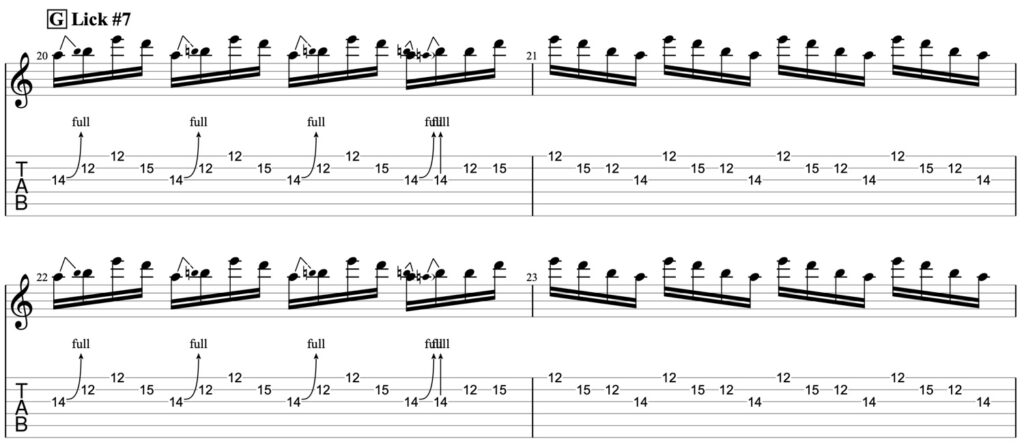
Free Bird, Lynyrd Skynyrd, anyone? This is the best solo to showcase what repeating patterns can do on the guitar.
What exactly is a repeating pattern?
It is a small group of notes played as a loop within a solo. It is a very common technique in rock to create catchy solos or pick up the intensity of a musical sequence.
In this example, there are two repeating pattern licks alternating in a question and response form. That kind of lick works wonders if the harmony is moving in the background (on a descending chord sequence for instance).
The lick will take on a different meaning with each new chord whereas you’re still playing the same thing.
#8: Pentatonic lick with unisson double stops

This lick is only made of unison double stops. Those kinds of bends with two sounds have been used very often in rock solos of the seventies and eighties by guitar players such as Brian May (Queen) or Jimmy Page (Led Zeppelin).
Here’s the idea: bend a full step on the B string in order to reach the same pitch as the note you’re fretting on the high E string. This is how you reach unison.
This technique may be used to play an epic melody within a solo. Unison creates an extra emotional layer that sets those notes apart from the rest of the solo.
#9: Pentatonic lick with sliding into notes

That kind of pentatonic lick is another staple of Joe Satriani’s playing. He is using the connection between positions 5 and 1 of the pentatonic scale (see patterns at the beginning of the article).
We start off each group of four notes with an ascending slide from position 5 of the pentatonic scale into the first position.
The slide puts the rhythmic emphasis on the 2nd sixteenth note of each group of four sixteenth notes.
#10: Pentatonic lick with a rhythmic shift

In this example, we are trying to create a rhythmic shift by adding silence in between the first two groups of four notes in the bar.
You can make your playing more original by using that rhythmic shift trick.
Guitar player Nuno Bettencourt (Extreme) uses those rhythmic motifs as lot as part of his solos.
#11: Pentatonic lick with alternate picking and legato

The fast alternate picking technique is a trademark of guitarist John Petrucci (Dream Theater).In order to make this lick sound as good as it can, I recommend you use distortion and palm muting for the alternate picking parts.
This concept will allow you to make your interpretation of the pattern more interesting by breaking away from the linear aspect of a lick played only in alternate picking or legato.
Feel free to experiment with it on other licks!
#12: Pentatonic lick on the 5 positions of the scale

This lick will take you through a large portion of the neck in very little time. It could almost be used as an exercise to work on left-hand moves and alternate picking.
The concept is fairly simple: play the five positions of the scale horizontally, focusing only on the D and G strings.
To make the lick less linear, I advise you to alternate between regular notes and palm-muted ones.
#13: Pentatonic lick on 3 octaves

Caution: this is a flashy lick! You may not know this yet, but the guitar allows you to easily play the pentatonic scale on three octaves.
In this example, you will play the same three notes from the pentatonic scale on three octaves on your guitar.
This lick really works to start off or finish a solo. It takes you very quickly from a low note to a very high note, hence its flashy effect.
#14: Pentatonic lick on 3 octaves with the blues scale

Here is a variation on the last lick which adds the “blue note”, here is an F since we’re using the pentatonic scale in the key of B minor.
To make it even more striking, feel free to end with a slide into a bombastic bend on a high note!
#15: Revisiting the pentatonic scale by changing a note

Why should you always keep the same five notes to play a pentatonic scale? In this example, we’re revisiting the scale by replacing the minor third with a major third.
Modifying this note only will create a more exotic and unexpected pentatonic scale which will work wonders on a chord sequence in A major or F# minor.
Here’s a tip: you can create new pentatonic scales by changing one note from it at random.
#16: Pentatonic lick on your new scale with a major third

Here is one of the many new licks that you can play using our revisited pentatonic from the last lick. Changing a single note is enough to create a whole new scale sound.
Pretty cool uh?
#17: Pentatonic lick with double stops

The pentatonic scale is a very expressive scale. It can sound very bluesy by creating various licks using double stops.
Those kinds of licks have been used throughout the years, from Stevie Ray Vaughan’s blues to Kirk Hammet’s thrash solos.
#18: Pentatonic lick with slides and bends

This lick was inspired by Steve Vai. It may seem simple on paper but it’s not that easy. It combines slides and bends to create the special effect of notes repeating.
Concentrate on the rhythm, as well as your fingerings to prepare for each bend.
This lick can even be used as an exercise to practice bending in tune.
#19: Pentatonic lick with ghost notes

With this lick, we are going to be using ghost notes (or dead notes) to create unexpected rhythmic figures within your solos.
This technique will allow you to create ascending or descending scales that don’t sound ordinary. If you’re playing that kind of lick with distortion, palm mute carefully with your right hand’s edge in order not to sound muddy.
#20: Pentatonic lick with shifts and unissons

Just like lick number 9, this lick uses the connection between the first and second positions of the pentatonic scale.
By using shifts, we can repeat the same notes on different strings to create original-sounding licks.
The stretches between your fingers can be quite wide, so concentrate on getting a good left-hand position, and don’t forget to warm up before playing.
#21: Pentatonic lick with tapping
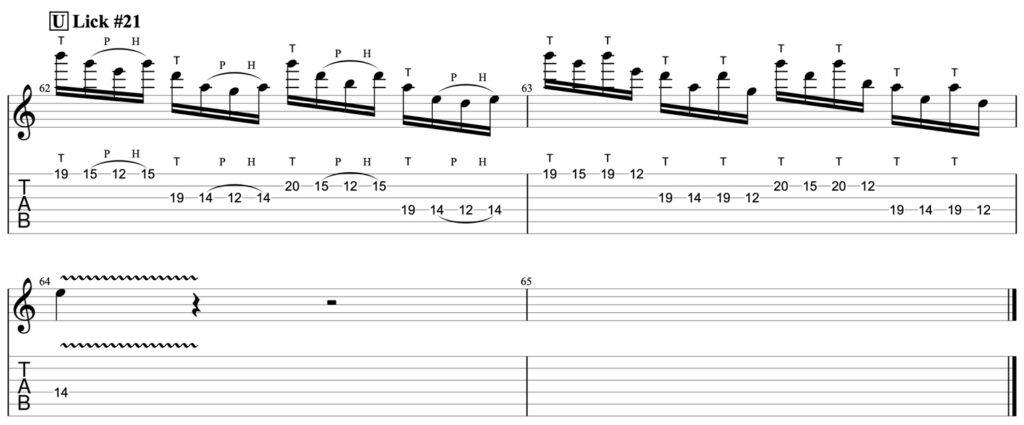
Tapping is a technique I seldom use, but it can be a very interesting one in order to create wide intervals between the notes you play.
This example uses tapping with string skipping, and only the most technically proficient guitarists will be able to play it!
This little technical challenge should keep you busy during your long winter nights!
Conclusion
This is it. Don’t forget to download the tablatures so you can work on these pentatonic licks at your own pace with the help of the Guitar Pro metronome.
Feel free to vary your interpretations and modify the licks to develop your own ideas and turn those examples from this list into your own music.
If you have any questions, feel free to write a comment. Either the Guitar Pro team or myself will be glad to answer.
Thank you for reading, and have fun playing!
Leave a comment
Your email address will not be published.
| Title | Artist | |
|---|---|---|
Lenny

|
Stevie Ray Vaughan | |
Country Roads

|
John Denver | |
Four on Six

|
Wes Montgomery | |
So What

|
Miles Davis | |
Boulevard of Broken Dreams

|
Green Day |

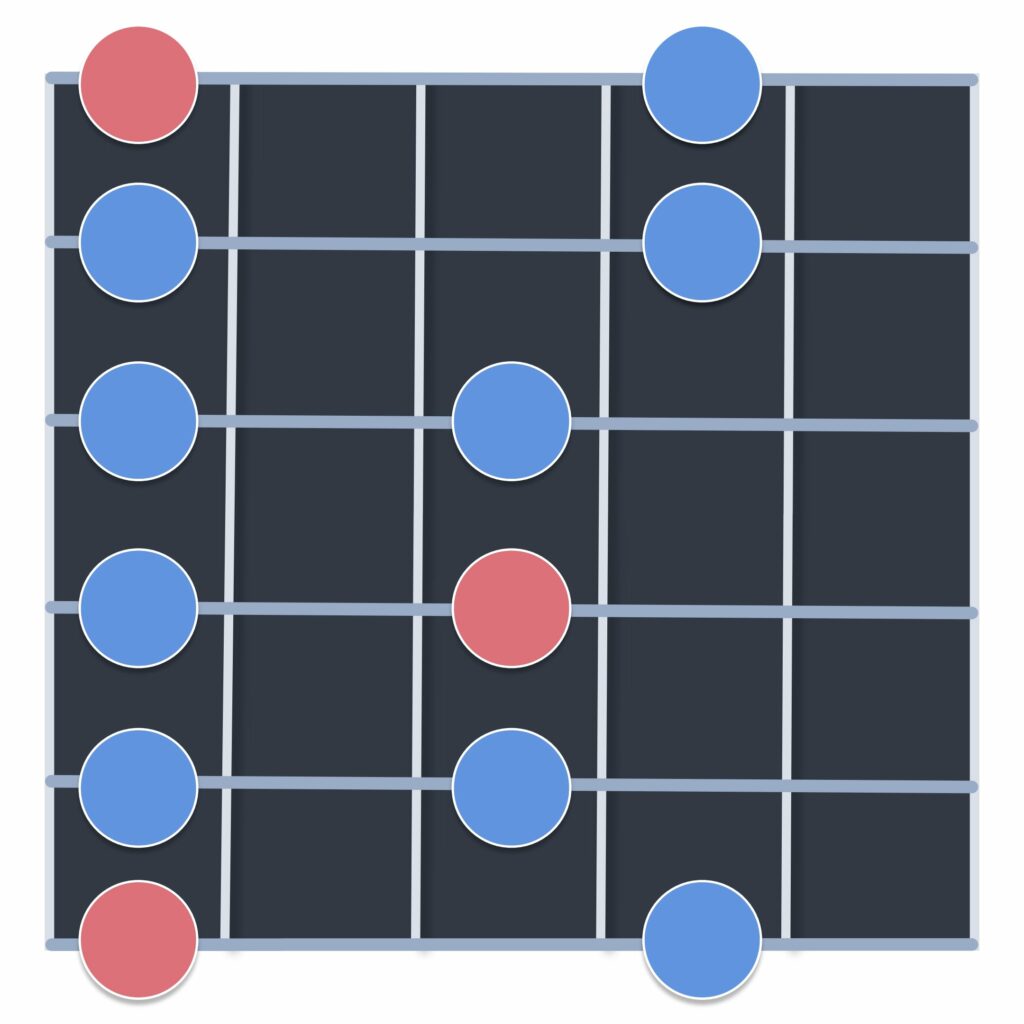
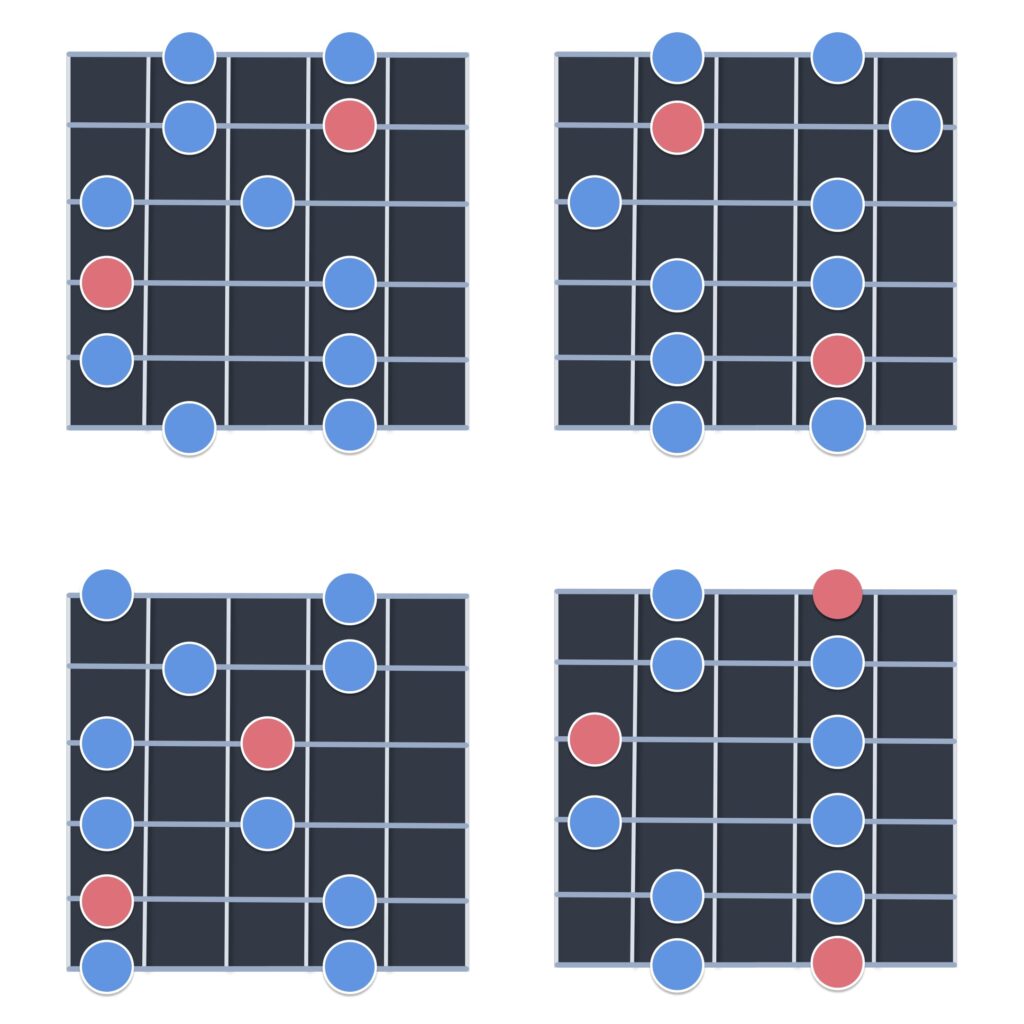

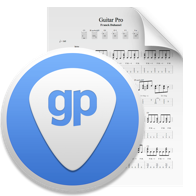


4 Comments
Please attach an audio with your licks also . I cant read music but I can hear and understand
Hi Sanjish, that would be great indeed. Stay tuned for new content with audio tracks soon.
In lick #2 where you have 2 pull-offs and 2 hammer-ons consecutively; are you only picking the first note (G string 15th fret)? Could you explain how to play those 5 note sections in lick #2?
Thanks
I have been using guitar pro for 15 years, and I upgraded to guitar pro 8 on May 2. Thank you, I have improved a lot!
But for the drums all the time, if you choose one part, other parts can only be the same. For example, if you choose kick (606), then snare, hihat, tom, and crash can only be (606), which is too bad
It would be nice if the drum parts could be combined freely, for example: kick (606) but snare is (fab) Hihat (909)…
I’ve been looking forward to it for a long, long, long time…..please